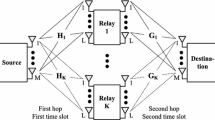Abstract
This study considers a wireless-powered relay assisting multisource multidestination (MSMD) communication networks. Specifically, a beamforming and power-allocation scheme for the relay node is proposed, where a multiple-input multiple-output amplify-and-forward relay node that operates with harvested energy mediates the communication between MSMD pairs. The joint optimization of the relay beamforming matrix and of the power-splitting ratio design for the purpose of maximizing the minimum signal-to-interference-plus-noise ratios (SINRs) is challenging owing to its nonconvexity. We therefore propose an efficient algorithm for finding the optimal solution. In addition, to reduce computational complexity, a zero-forcing beamforming-based suboptimal relay design method is also presented. Simulation results show the effectiveness of the proposed schemes in terms of both SINR and sum-rate performances.


Similar content being viewed by others
Notes
‘Compute-and-forward network coding with lattices’ protocol in [9] can be broadly classified into DF relay protocols since lattice-mapping is necessary at the relay node.
Owing to the zero-forcing nature of the relay beamforming matrix, rank(\({\varvec{\Lambda }}\)) \(=K\) is sufficient for adjusting the SINR of each link. Thus, when \(N_r> K\), \(\lambda _{i}=0\) (\(i\ge N_r-K+1\)).
Strictly speaking, this is the signal-to-noise ratio (SNR), because inter-user interferences are cancelled out by the ZF beamformer.
Without EH, 15 (dB) generally represents an intermediate level of SNR (within the context of signal detection); with EH, it represents a low SNR level, resulting from power splitting to harvest energy.
References
Raghunathan, V., Ganeriwal, S., & Srivastava, M. (2006). Emerging techniques for long lived wireless sensor networks. IEEE Communications Magazine, 44, 108–114.
Xiong, K., Fan, P., Zhang, C., & Letaief, K. B. (2015). Wireless information and energy transfer for two-hop non-regenerative MIMO-OFDM relay networks. IEEE Journal of Selected Areas in Communications, 33, 1595–1611.
Li, B., & Rong, Y. (2018). Joint transceiver optimization for wireless information and energy transfer in non-regenerative MIMO relay systems. IEEE Transactions on Vehicular Technology, Early Access.,. https://doi.org/10.1109/TVT.2018.2846556.
Huang, Y., & Clerckx, B. (2016). Relaying strategies for wireless-powered MIMO relay networks. IEEE Transactions on Wireless Communications, 15, 6033–6047.
Truong, K. T., Sartori, P., & Heath, R. W. (2013). Cooperative algorithms for MIMO amplify-and-forward relay networks, Wireless Personal Commun. IEEE Transactions on Signal Processing, 61, 1272–1287.
Choi, H., Song, C., Park, H., & Lee, I. (2014). Transceiver designs for multipoint-to-multipoint MIMO amplify-and-forward relaying systems. IEEE Transactions on Wireless Communications, 13, 198–209.
Ding, Z., Perlaza, S. M., Esnaola, I., & Poor, H. V. (2014). Power allocation strategies in energy harvesting wireless cooperative networks. IEEE Transactions on Wireless Communications, 13, 846–860.
Wang, X., Liu, J., & Zhai, C. (2017). Wireless power transfer-based multi-pair two-way relaying with massive antennas. IEEE Transactions on Wireless Communications, 16, 7672–7684.
Wang, S., Xia, M., & Wu, Y. (2016). Multipair two-way relay network with harvest-then-transmit users: Resolving pairwise uplink-downlink coupling. IEEE Journal of Selected Topics in Signal Processing, 10, 1506–1521.
Salem, A., & Hamdi, K. A. (2016). Wireless power transfer in multi-pair two-way AF relaying networks. IEEE Transactions on Communications, 64, 4578–4591.
Rahimian, S., Jing, Y., & Ardakani, M. Performance analysis and optimization of 3D massive MIMO multi-pair relaying with SWIPT. Available at arXiv:2001.11803.
Luo, Z., Ma, W., So, A. M., Ye, Y., & Zhang, S. (2010). Semidefinite relaxation of quadratic optimization problems. IEEE Journal on Selected Areas in Communications, 30, 20–34.
Boyd, S., & Vandenberghe, L. (2004). Convex optimization. Cambridge: Cambridge University Press.
Author information
Authors and Affiliations
Corresponding author
Additional information
Publisher's Note
Springer Nature remains neutral with regard to jurisdictional claims in published maps and institutional affiliations.
Rights and permissions
About this article
Cite this article
Shin, J. Min-SINR-Maximizing Wireless-Powered AF Relay for Multisource and Multidestination Networks. Wireless Pers Commun 116, 1785–1793 (2021). https://doi.org/10.1007/s11277-020-07761-w
Published:
Issue Date:
DOI: https://doi.org/10.1007/s11277-020-07761-w




